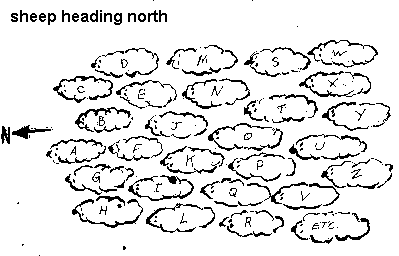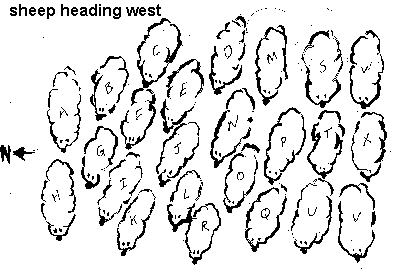| If you don't squeeze nothing comes out... | ||||||||||||||
|
T F
|
||||||||||||||
RUNNING TO THE FRONT OF THE FLOCK |
||||||||||||||
 |
||||||||||||||
|
Running to the front of the flock, uses the flock of sheep as a model for changes in fashion. Fashion is perhaps most closely associated with clothing and hair styles. This is perhaps because these things change so noticeably and seemingly arbitrarily. However, there are fashions in speech, music, politics, and of course the visual arts. The flock is running in some direction and there are sheep who are at the front at that time, these sheep could be considered the leaders. Then the flock changes direction. Sometimes suddenly, sometimes gradually, but as the flock changes direction the position of the sheep relative to the front also changes. The sheep who were the leaders when the flock was going, let us say north, are now toward the side and back as the flock has changed directions to head west. The sheep who were on the left side of the flock when it was heading north are now leading the flock. I have used the flock of sheep to emphasize that there is no real leadership here. The sheep are all just running around in a group. If you were one of the sheep you could of course have the impression that the leadership had changed and that a new direction was an important change for the better. Now there are some sheep who are always running as fast as they can to get to the front. If they can run fast enough and if the direction stays constant long enough they may eventually become leaders. |
Also there are those, who like the sheep on the left side of the flock above, suddenly find themselves in a leading position, even though just a short time ago they were running along the edge. Hopefully how this applies to contemporary art is apparent enough. There are artists who continually try to move their style, content, approach in the direction of whatever is hip and hot at the moment. There are also artists who were running along side the flock who find themselves leading in the new direction. Of course there are those who are always changing direction a little too late and find themselves forever at the back of the flock. Although I believe the above to be a valuable model for imagining the dynamics of the changes in fashion I would say that detailed knowledge of the positions of the sheep (artist) at any time is not of particular importance to appreciating art. Those who are primarily concerned with which sheep are where and where they are headed are journalist, this is their job - to report the news. And historians are interested in the placement and direction of the sheep in the past. What I hope to discourage by proposing this model is evaluating an artist work based their position within the flock. Leadership in the arts is often illusionary. The slightest reflection on the succession of styles, movements, attitudes, and values of art of the last 30 years will show how fickle the flock can be in its direction. |
|||||||||||||
|
Email Credits
|
||||||||||||||
|
|
||||||||||||||
E
|
||||||||||||||
THE EMPEROR'S NEW CLOTHES |
||||||||||||||
|
The story of The Emperor's New Clothes is hopefully familiar enough that the briefest of summaries will suffice in recollecting it for treatment here. Two men come to town and find out that the Emperor loves the finest and rarest of clothes. They present themselves to the Emperor as purveyors of the finest and rarest of garments made of fabrics so delicate that only the most discerning and sensitive person can perceive them at all. The Emperor commissions the men to make him some garments from this rare almost imperceptible fabric. The men then make the garments and the king wares them on parade. At which point a child points at the Emperor and proclaims him to be naked. These are the "facts of the story". I have deliberately avoided the traditional "spin" that portrays the clothers as swindlers, the king as a vain dupe, and his court and subjects as sheepish followers who were afraid to reveal to each other that they saw nothing, for fear of appearing to obtuse not to perceive something so fine that they could not see it. The reason to avoid the traditional interpretation is that this little fable tells us more about the values and prejudices of the people who tell it than may be admitted by them, even to themselves. It is also a myth that is of particular pertinence to contemporary art. It is not hard to imagine a child being bored in a contemporary art gallery. Perhaps the child sees nothing? Certainly, if they are bored, they see nothing of value.Does it follow then that there is nothing there and we have all been duped? |
This is a favorite attitude of people who's appreciation of art stopped developing in childhood. To temporarily get away from the plastic arts, let us look at films through those pure and untainted eyes of a child. Most of the films that are considered at all seriously by any adult of moderate maturity are a great bore to most children. The reverse is also somewhat true, however; most adults, even complex and sensitive ones, can still be amused by the simpler stories favored by children. Of course there are those whose appreciation is suspect, precisely because they seem all too eager to prove that they appreciate some subtle nuance that is suddenly fashionable. To these people the question of the Emperor being naked or clothed is moot, they are more interested in convincing others of their superiority than actually perceiving anything at all. And the demise of imperial courts has done nothing to diminish their numbers. There is the interpretation that the clothes were real and worth every cent, and that the Emperor was the most perceptive of aesthetes. That the court was divided between those who saw something and those who saw nothing, with those unable to see carefully going along so as not to seem too obtuse. Another scenario is that the emperor saw nothing and so much of the court assumed the same attitude, although there may be an unofficial recognition of perceiving something rare and valuable by perceptive aesthetes who would make up something like the avant garde. |
|||||||||||||
BANDWAGONS |
||||||||||||||

